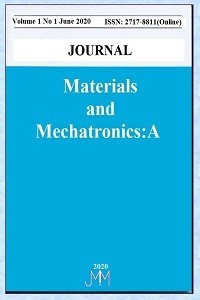Toz Metalurjisi Yöntemiyle Üretilen Fe Esaslı Fe-Ni-Cu Elmas Kesici Takımında Co’ın Etkisi
Elmas kesici takımlar, Toz metalurjisi, Kobalt, Demir esaslı alaşım
The Effect of Co on Fe-Based Fe-Ni-Cu Diamond Cutting Tool Produced by Powder Metallurgy Method
Diamond cutting tools, Powder metallurgy, Cobalt, Iron baded alloy,
___
- Aronsson B., On the origins and early growth of stainless steel: A survey with emphasis on the development in Sweden. Outokumpu Stainless research foundation, 2010.
- Kulaksız S., Doğaltaş (Mermer) Maden İşletmeciliği ve İşleme Teknolojileri. TMMOB Maden Mühendisleri Odası Yayınları, Ankara, No: 126, 624, 2007.
- Burgess R. R., Man-made diamond for stone processing, Proc. 1st Technical Symposium, Bucharest, Romania, October 5-6, 1978.
- Thakur U. N., The role of metal powders in manufacturing diamond tools. Proc. Superabrasives'85, Chicago, Illinois, USAS April 22-25, MR85-307, 1985.
- Dwan J. D., HP/HT manufacturing of diamond, www.nantech.ie., 1998.
- Hamar-Thibault S., Allibert C. H., Tillman W., Phase constitution of Cu77Sn8Ti14Zr1 as a binder for diamond tools, Proc. International Workshop on Diamond Tool Production, Turin, Italy, November 8-10, 1999, pp: 57-64.
- Gasik M. M., Kervinen Po., Kaskiala M., Graf P., In situ sintering studies of cobalt powders for diamond tools, Prac, International Workshop on Diamond Tool Production, Turin, Italy, November 8-10, 1999, pp: 107-112.
- Cram A. S. D., Hot isostatic pressing, Proc. Seminar on PM Diamond Tools, Lausanne, Switzerland, November 2-3. 1995.
- Ojeda R. G., del Villar M., Muro P., Iturriza L., Castro F., Densification of diamond tools with Co, Ni and Fe based metallic binders, Proc. PM World Congress & Exhibition, Granada, Spain, 1998, pp: 481-486.
- Samvelion R.V., Manoukion N.V., Extrusion for diamond tool production, Proc. Seminar on PM Diamond Tools, Lausanne, Switzerland, November 2-3, 1995.
- Grüneis H. T., Sintering and brazing all in one, Industrial Diamond Review, No. 25, 45-47, 1998.
- Schmid H. G., Diamond tool production using the DIAPLATE process. Proc. Seminar on PM Diamond Tools, Lausanne, Switzerland, November 2-3, 1995.
- Fiechter A., Schneiden und Schweissen mit gepulsten Nd:YAG Laser, Proc. Seminar on PM Diamond Tools, Lausanne, Switzerland, November 2-3, 1995.
- Fayed M. E., Otten L., Handbook of Powder Science and Technology. New York: Chapman & Hall,1997.
- German R., Powder Metallurgy Science. New Jersey: Princeton, 1994.
- German R., Toz metalurjisi ve Parçacıklı Malzeme İşlemleri. Ankara: TTMD Yayınları, 2007.
- Chang I., Zhao Y., Advances in Powder Metallurgy: Properties, Processing and Applications. Woodhead Publishing, 2013.
- Froes F. H., Eylon D., Eichelman G. E., Burte H. M., Developments in titanium powder metallurgy. JOM, 32(2), 47-54, 1980.
- Qian M., Froes F. H., Titanium powder metallurgy: science, technology and applications. Butterworth-Heinemann, 2015.
- Konstanty J., Sintered diamond tools the past, present and future. Archives of Metallurgy and Materials 66(2), 593-599, 2021.
- Konstanty J., Tyrala D., Easily sinterable low alloy steel powders for P/M diamond tools. Metals, 11(8), 1204, 2021.
- Oishi M., Prospects for cobalt demand. Cobalt News 5 January 11-14, 1979.
- Güneş Ç., Ni Esaslı Katkı Malzemelerinin Matris Özelliklerine Etkisinin Araştırılması, Munzur Üniversitesi Lisansüstü Eğitim Enstitüsü, Yüksek Lisans Tezi (Basılmış), 2022.
- Karaduman O., Structural and thermodynamical study of Cu-Zn-Al shape memory alloys with new compositions produced by hot isostatic press (HIP). In AIP Conference Proceedings, 2178(1), 30-40, 2019.
- Nguyen V. M., Spark plasma sintering of cobalt powders in conjunction with high energy mechanical treatment and nanomodification. Processes, 8(5), 627, 2020.
- Tyson W. R., Surface energies of solid metals. Canadian Metallurgical Quarterly 14(4), 307-314. 1975.
- Uhlmann E., Polte M., Bolz R., Börnstein J., Fundamental research of applying tungsten carbide-cobalt as tool electrode material for sinking EDM. Procedia CIRP, 95, 466-470. 2020.
- Jamrozek J. B., Processing and characterization of Fe-Cu-Ni sinters prepared by ball milling and hot pressing. Arch. Metall Mater, 65(3),1157-1161, 2020.
- Li M., Fabrication of Fe-based diamond composites by pressureless infiltration. Materials 9(12), 1006, 2016.
- Ghosh B., Defect induced room temperature ferromagnetism in single crystal, polycrystal, and nanorod ZnO: A comparative study. Journal of Applied Physics 123(16), 161507, 2018.
- Çelik E., Elmaslı kesici takımlarda alternatif bağlayıcılar, Fırat Üniversitesi Fen Bilimleri Enstitüsü, Doktora Tezi (Basılmış), 2009.
- Yayın Aralığı: Yılda 2 Sayı
- Başlangıç: 2020
- Yayıncı: Yusuf KAYALI
Nursel ALTAN ÖZBEK, Onur ÖZBEK
Mehmet Şamil AKÇAY, İsmail KOYUNCU, Murat ALÇIN, Murat TUNA
Sinter-Alüminize T/M Çeliklerin Özellikleri ve Korozyon Davranışı
Ahmet MASLAVİ, Hüseyin ÜNAL, Alim KAŞTAN
Derin Öğrenme ile Trafik İşareti Tanıma Algoritmasının Gerçek Zamanlı Uygulaması
Faruk Emre AYSAL, Kasım YILDIRIM, Enes CENGİZ
Toplu Öğrenmeye Dayalı Çelik Levha Arızalarını Sınıflandırması İçin Bİr Yöntem
Çift Sargılı IPM Makinaların Çalışma Modları ve Geçici Halleri Üzerine Sayısal İncelemeler
Ferhat CERİTBİNMEZ, Erdoğan KANCA
Kurşun Asit Bataryalar için SOC Tahmini Yaklaşımını İçeren Bir Batarya Yönetim Sistemi Tasarımı
Emre AKARSLAN, Said Mahmut ÇINAR
Biyoyenilenebilir Enerji Tabanlı Mikro Şebekenin Yük Frekansı Kontrolü İçin Fuzzy PID Kontrolör
